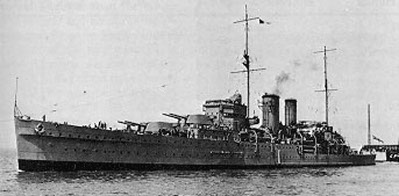| York class Heavy
Cruisers |
| |
| Individual
Specification |
| Name |
Pennant |
Completed |
Builders |
Fate |
| York |
n/a |
1 May 1930 |
Palmers |
Sank Suda Bay 22 May 1941.
Salvaged and scrapped 1952. |
| Exeter |
n/a |
23 July 1931 |
Devenport RDY |
Sunk 1 Mar. 1942 , South Java Sea |
| |
 |
| 1:600 Exeter, as she was
in the River Plate battle. 4" AA are paired, after
funnel is thickened and an amphibian is carried on the
catapult. © Andrew Arthur |
These two ships were a "B" Class
diminutive of the "A" or "County"
Class heavy cruisers, a 25% reduction in main armament producing
a commensurate reduction in cost. Although 7 ships were
originally planned only two were built because of successive
cutbacks in defence spending.
While their particulars were almost identical, they differed in
appearance: Exeter had straight masts and funnels, while
those of York were raked. Moreover, Exeter's bridge
structure was of the "box" type (next seen in the
"Leander" Class light cruisers), while that of York
was a smaller version of the structure in the
"Devonshire" Class.
This was because York had been designed to carry a
catapult and amphibian on "B" turret, but, when the
turret proved to be too light for this arangement, the tall
bridge to obtain a clear view over the plane, and raked funnels
to keep smoke out of the bridges remained.
Both ships had short careers in World War I, Exeter being
best remembered for her participation in the Battle of the River
Plate which led to the scuttling of the German pocket-battleship Graf
Spee.
They were the last Heavy cruisers built for the Royal Navy.
| Pictures of York
class Heavy Cruisers |
 |
| HMS Exeter |
| |
| Dimensions |
Net displacement |
8250 tonnes |
Length |
575' |
| Gross
displacement |
10500 tonnes |
Beam |
58' |
| Load |
2250 tonnes |
Draught |
17' |
| Performance &
Propulsion |
| Range |
10000 miles @ 14 kts |
Speed |
32.25 kts |
| Propulsion |
8 x Admiralty 3-drum boilers, 4 x
Parsons steam turbines @ 80000 hp |
| Armament,
Armour & Complement |
| Complement |
620 Officers & Ratings |
Aircraft |
1 Supermarine Walrus |
| Armament |
- Gun
- 3 x
2 x 8" / 50 Mk.8
- 4 x
1 x 4" / 45 QF Mk.5 HA
- 2 x
1 x 2 pdr pom-pom
AA
- 2 x 4 x 0.5" MG AA
- Torpedo
|
Armour |
- 3"
main belt
- 1.375"
deck
- 1" -
4" magazines
- 1"
bulkheads
- 4"
Boiler rooms
|
| Armament, Exeter
1941 |
- Gun
- 3 x 2 x 8"/50-cal
- 4 x 2 x 4"/50-cal AA
- 2 x 8 x 2pdr pom-poms
- 4 x 1 x 20mm Oerlikon AA
|
| Service
Histories - Provided By Bruce T. Swain |
| York |
- 8th Cruiser Squadron Sep. 1939
- Atlantic convoy escort Sep.-Oct.
1939
- Atlantic convoy cover Nov.
1939-Mar. 1940
- intercepted German blockade runner
Aracus 3 Mar. 1940
- joined Home Fleet off Norway 9
Apr. 1940
- Norwegian campaign Apr.-May 1940
- reinforced Channel Forces 10 May
1940
- 18th Cruiser Squadron Home Fleet
May-Jul. 1940
- escorted convoy to Suez via the
Cape Aug.-Sep. 1940
- joined Mediterranean Fleet 24 Sep.
1940
- 3rd Cruiser Squadron Sep.
1940-Mar. 1941
- sank Italian destroyer Artigliere
13 Oct. 1940
- escorted Illustrious during
Taranto raid Nov. 1940
- transported troops to Greece Nov.
1940
- convoy cover operations with Med.
Fleet Dec. 1940
- with Illustrious when that
carrier was severely damaged by air attack 10
Jan. 1941
- transported troops to Greece Mar.
1941
- severely damaged by Italian
explosive motor-boats in Suda Bay, Crete, 26 Mar.
1941
- beached and used as AA battery
until badly damaged by bombs 22 May
- scuttled (main armament destroyed)
the same day as Germans overran Crete
- wreck salvaged and towed to Bari,
Italy
- scrapped 3 March 1952
|
| Exeter |
- Assigned to South American
Division of America and West Indies Squadron Sep.
1939
- formed raider hunting group G with
Cumberland and later joined by light
cruisers Ajax and Achilles 5 Oct.
1939
- with Ajax and Achilles
engaged German pocket-battleship Graf Spee
in Battle of the River Plate 13 Dec. 1939 -
suffered severe damage (all 8" guns out of
action, 10-degree list, 650 tons of water
shipped) and withdrew to the Falklands
- under repair at Port Stanley Dec.
1939-Jan. 1940
- further repairs and modifications
to armament at Devonport Dockyard
- elevation of 8" guns
increased to 70-degrees
- single 4" guns
replaced by twins
- 2pdr and 20mm AA added
- pole masts replaced by
tripods
- joined Eastern Fleet Dec. 1941
- assigned to ABDA naval forces Jan.
1942
- fought in Battle of Java Sea 27
Feb. 1942 - hit by 8" shell in boiler room
and withdrew to Soerabaja
- sailed 1 Mar. 1942 with destroyers
HMS Encounter and USS Pope
- engaged by 4 Japanese heavy
cruisers and 4 destroyers in Java Sea, sunk by
gunfire and torpedoes.
|
| |
|
| Back |
|


